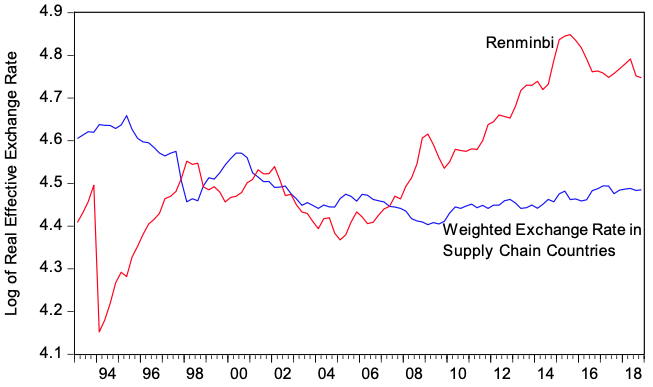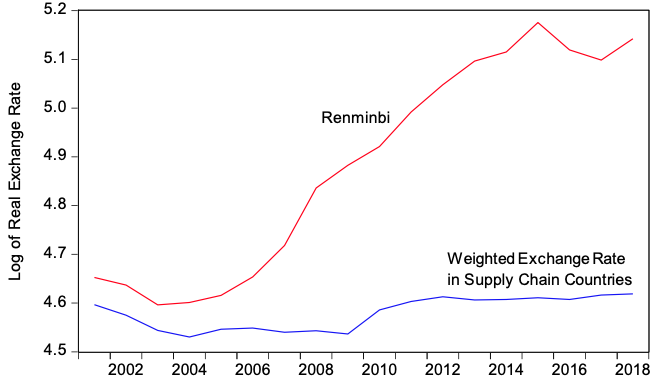As the trade surpluses of East Asian countries have continued to exist in regional value chains despite the US-China trade war, one possible tool such economies could employ are currency appreciations. This column shows how exchange rates in upstream countries affect China's exports. No single economy wants to appreciate its currency against the US dollar for fear of losing competitiveness, but a concerted effort to prioritise regional currencies could benefit the set of countries as a whole.
Setser (2019) noted that China has run a current account surplus of $250 billion over the last four quarters and that South Korea, Japan, Taiwan, Singapore, and other East Asian countries also run large surpluses. He observed that these trade imbalances are likely to get worse before they get better.
Trade surpluses in East Asian countries are interrelated. Korea, Taiwan, Japan, and the Association of Southeast Asian Nations (ASEAN) send parts and components to China. China adds value to these and then re-exports the final and intermediate goods to the rest of the world.
Asia's surpluses have generated protectionist pressures and a trade war with the US. These impediments to trade are difficult for the region because exporting led to miraculous growth in Japan, South Korea, Taiwan, ASEAN, and China.
Asia could work with the US to reduce these imbalances and attenuate protectionist pressures. A precedent for this is the 1985 Plaza Accord, when France, Germany, Japan, and the UK deflected US protectionist pressures by appreciating their currencies against the dollar. The US in turn agreed to reduce its budget deficit. The Accord was followed a few years later by the last current account surplus the US has run.
Exchange rates and China's processed exports
How would appreciations affect East Asia's surpluses? China's surpluses are concentrated in the processing trade regime. Imports for processing are parts and components that enter China duty free and that can only be used to produce goods for re-export. Processed exports are the final goods produced using imports for processing. China's global surpluses in processing trade exceeded $300 billion in every year from 2010 and 2018. Its surpluses on ordinary trade, on the other hand, rise and fall with the value of imported primary products and averaged $85 billion per year over this period.
Imports for processing come mainly from East Asia, and China runs deficits in processing trade with leading suppliers such as South Korea and Taiwan. This implies that China's surpluses in processing trade are actually Asian surpluses.
Cheung et al. (2012), using the CPI-deflated real effective exchange rate and dynamic ordinary least squares (DOLS) estimation over the 1994Q3-2010Q4, reported that a 10% RMB appreciation would reduce processed exports by between 9% and 12%. Patel and Wei (2019) noted that processed exports should also depend on exchange rates in supply chain countries. If Japan produces parts that go into phones that China exports, a weaker yen should increase the price competitiveness of China's phones.
In a recent paper, I investigated how exchange rates in upstream countries affect China's exports (Thorbecke 2019). I calculated a supply chain exchange rate (SSRER) as the geometrically weighted average of exchange rates in the nine countries providing the most imports for processing to China (Note 1). I then included SSRER in a DOLS regression together with the CPI-deflated renminbi real effective exchange rate and GDP in OECD countries to explain processed exports. The results indicate that a 1% appreciation of the renminbi would reduce the volume of processed exports by 1.3% and that a 1% appreciation in supply chain countries would reduce exports by 2.7%.
How have the renminbi and exchange rates in supply chain countries evolved? Figure 1 shows that the renminbi has appreciated 10% between the first quarter of 2012 and the last quarter of 2018. It also shows that SSRER has the same value at the end of 2018 as it did in the first quarter of 2012. Over this period 55% of SSRER's value has been driven by Taiwanese and Korean exchange rates and 80% by Taiwanese, Korean, Japanese, and Singaporean exchange rates. Taiwan's current account surplus from 2010 to 2018 averaged 12% of GDP, Korea's averaged 5.7%, Japan's averaged 2.5%, and Singapore's averaged 17%. In spite of these enormous surpluses, their currencies barely appreciated.

Source: CEIC Database and calculations by the author.
Exchange rates and China's electronics exports
China's surpluses in electronics goods have averaged $330 billion per year since 2011. This equals more than half of China's overall surplus. Electronics goods include consumer electronics, telecommunications equipment, computer equipment, electronic components, precision instruments, clocks and watches, and optical goods. China's electronics exports are produced using electronic parts and components (EP&C) from upstream countries. Since 2000, more than 90% of China's imports of electronic parts and components has come from Taiwan, South Korea, Malaysia, Japan, Singapore, the Philippines, the US, Thailand, and Germany (Note 2).
To investigate how exchange rates in upstream countries affect the price competitiveness of China's electronics exports, I constructed a weighted average of exchange rates (WRER) in these leading suppliers of EP&C to China. I then included WRER together with the renminbi exchange rate and GDP in importing countries in a panel DOLS regression of China's electronics exports to leading importers. The results indicate that a 1% appreciation in countries providing EP&C to China would reduce China's electronics exports by 1.4% and that a 1% appreciation of the renminbi would reduce exports by 1.19%. These results and the results for processed exports both indicate that appreciations in supply chain countries cause larger decreases in China's exports than appreciations of the renminbi.
Figure 2 presents WRER and the renminbi exchange rate. The figure shows that by this measure also the renminbi has appreciated significantly but that exchange rates in supply chain countries have not. This supports the findings in Figure 1 with very different exchange rate measures indicating that, despite large current account surpluses, exchange rates in Korea, Taiwan, Japan, and Southeast Asian countries have not appreciated.

Source: CEPII-CHELEM database and calculations by the author.
Discussion
The US named China a currency manipulator. The findings reported above indicate that, if President Trump is concerned about China's export penetration, it would be more productive to focus on currencies such as the Korean won, the New Taiwan dollar, the Japanese yen, and the Singapore dollar.
It would be difficult for Korea, Taiwan, Japan, and other Asian economies if their currencies appreciated. However, appreciations would disrupt trade much less than equivalent tariffs. Benassy-Queré et al. (2018) investigated bilateral trade flows between 110 countries at the Harmonized System (HS) six-digit level. They found that a 10% tariff reduces exports by 1.3% and that a 10% exchange rate appreciation reduces exports by 0.5%. Tariffs thus reduce exports three times more than appreciations do. This effect is called the international elasticity puzzle, and has also been reported by Fontagné et al. (2018), Fitzgerald and Haller (2014), and Ruhl (2008).
The disruption caused by tariffs is multiplied by the uncertainty that accompanies trade wars and protectionism. Bloom (2009) showed that heightened uncertainty deters investment. Capital formation is crucial for East Asia's flagship industry, electronics, and for many other industries. By reducing investment, uncertainty jeopardises the ability of Asian firms to stay close to the technological frontier.
Appreciations would not only be less disruptive than tariffs and trade wars but would also benefit countries in the region by increasing the purchasing power of consumers and allowing them to import more. Cheung et al. (2015), using an autoregressive distributed lag model over the 2001Q1 – 2012Q4 period, reported that 90% of China's imports from the US are from the "ordinary trade" customs regime and that a 10% renminbi appreciation would increase ordinary imports by 17%. In Thorbecke (2011), using panel DOLS estimation and data from 1979 to 2007, I reported that exchange rate appreciations would increase consumption imports into several East Asian countries. Updating the estimates up to 2017 confirms that appreciations in East Asia still increase imports (see Thorbecke 2019). These results imply that stronger exchange rates may allow Asian consumers to supplant American consumers as a source of demand for the region's exports.
To strengthen the potential for East Asia to be an engine of growth, economies in the region should establish ironclad free trade agreements among themselves. As countries in the region face thorny conflicts with each other, they should eschew protectionism and employ other policy instruments to address their disagreements.
To appreciate together Asian countries need to decrease the weight of the US dollar in their implicit currency baskets. Ogawa and Ito (2002) noted that if an important trading partner of Asian country A puts heavy weight on the US dollar, it may cause country A to do so also. This can produce a Nash equilibrium. On the other hand, if A's trading partner put more weight on regional currencies, then it may be optimal for A to put more weight on regional currencies. This would also be a Nash equilibrium. Putting more weight on regional currencies however would facilitate a concerted appreciation against the dollar.
No Asian country wants to let its exchange rate appreciate against the US dollar for fear of losing price competitiveness relative to its Asian neighbours. However, perennial surpluses put pressure on their currencies to appreciate. Policymakers should consider acceding to these market forces and allowing their currencies to appreciate together. In addition, if Japan put less emphasis on its 2% inflation target the yen could appreciate. If South Korea and Taiwan reduced outflows from insurance companies and government pension funds, the won and New Taiwan dollar could appreciate. If China extended fewer high interest rate loans to poorer countries, the renminbi could appreciate. None of these countries should act unilaterally though. Rather, given the intricate value chains linking Japan, Korea, Taiwan, China, and ASEAN, policymakers should view exchange rates as a regional issue and confer deeply about exchange rate policy. They could propose a deal with the US resembling the Plaza Accord whereby their currencies appreciate against the dollar in response to assurances of free trade and reductions in US budget deficits.
East Asia's miraculous growth occurred as Asian countries succeeded at exporting in industries such as electronics with tight profit margins. Investments in human and physical capital and the discipline of competing in world markets contributed to learning by doing and productivity growth. Exchange rate appreciations could act as a stick and open markets abroad as a carrot to goad Asian firms to continue innovating and adopting new technologies.
Author's note: The main research on which this column is based (Thorbecke 2019) first appeared as a Discussion Paper of the Research Institute of Economy, Trade and Industry (RIETI) of Japan.
This article first appeared on www.VoxEU.org on November 6, 2019. Reproduced with permission.


